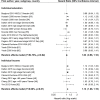Socioeconomic Differences and Lung Cancer Survival-Systematic Review and Meta-Analysis
- PMID: 30542641
- PMCID: PMC6277796
- DOI: 10.3389/fonc.2018.00536
Socioeconomic Differences and Lung Cancer Survival-Systematic Review and Meta-Analysis
Abstract
Background: The impact of socioeconomic differences on cancer survival has been investigated for several cancer types showing lower cancer survival in patients from lower socioeconomic groups. However, little is known about the relation between the strength of association and the level of adjustment and level of aggregation of the socioeconomic status measure. Here, we conduct the first systematic review and meta-analysis on the association of individual and area-based measures of socioeconomic status with lung cancer survival. Methods: In accordance with PRISMA guidelines, we searched for studies on socioeconomic differences in lung cancer survival in four electronic databases. A study was included if it reported a measure of survival in relation to education, income, occupation, or composite measures (indices). If possible, meta-analyses were conducted for studies reporting on individual and area-based socioeconomic measures. Results: We included 94 studies in the review, of which 23 measured socioeconomic status on an individual level and 71 on an area-based level. Seventeen studies were eligible to be included in the meta-analyses. The meta-analyses revealed a poorer prognosis for patients with low individual income (pooled hazard ratio: 1.13, 95 % confidence interval: 1.08-1.19, reference: high income), but not for individual education. Group comparisons for hazard ratios of area-based studies indicated a poorer prognosis for lower socioeconomic groups, irrespective of the socioeconomic measure. In most studies, reported 1-, 3-, and 5-year survival rates across socioeconomic status groups showed decreasing rates with decreasing socioeconomic status for both individual and area-based measures. We cannot confirm a consistent relationship between level of aggregation and effect size, however, comparability across studies was hampered by heterogeneous reporting of socioeconomic status and survival measures. Only eight studies considered smoking status in the analysis. Conclusions: Our findings suggest a weak positive association between individual income and lung cancer survival. Studies reporting on socioeconomic differences in lung cancer survival should consider including smoking status of the patients in their analysis and to stratify by relevant prognostic factors to further explore the reasons for socioeconomic differences. A common definition for socioeconomic status measures is desirable to further enhance comparisons between nations and across different levels of aggregation.
Keywords: area-based; cancer survival; education; income; index; lung cancer; occupation; socioeconomic status.
Figures






Similar articles
-
Impact of socioeconomic status on incident heart failure and left ventricular dysfunction: systematic review and meta-analysis.Eur Heart J Qual Care Clin Outcomes. 2019 Apr 1;5(2):169-179. doi: 10.1093/ehjqcco/qcy047. Eur Heart J Qual Care Clin Outcomes. 2019. PMID: 30295783
-
Association between pacifier use and breast-feeding, sudden infant death syndrome, infection and dental malocclusion.JBI Libr Syst Rev. 2005;3(6):1-33. doi: 10.11124/01938924-200503060-00001. JBI Libr Syst Rev. 2005. PMID: 27819973
-
Socioeconomic position and survival after lung cancer: Influence of stage, treatment and comorbidity among Danish patients with lung cancer diagnosed in 2004-2010.Acta Oncol. 2015 May;54(5):797-804. doi: 10.3109/0284186X.2014.1001037. Epub 2015 Mar 12. Acta Oncol. 2015. PMID: 25761702
-
Association of Socioeconomic Status With Ischemic Stroke Survival.Stroke. 2019 Dec;50(12):3400-3407. doi: 10.1161/STROKEAHA.119.026607. Epub 2019 Oct 15. Stroke. 2019. PMID: 31610765
-
Education, income and occupation and their influence on the uptake of cervical cancer prevention strategies: A systematic review.J Clin Nurs. 2020 Feb;29(3-4):393-415. doi: 10.1111/jocn.15094. Epub 2019 Dec 10. J Clin Nurs. 2020. PMID: 31713934
Cited by
-
Disparities in All-cancer and Lung Cancer Survival by Social, Behavioral, and Health Status Characteristics in the United States: A Longitudinal Follow-up of the 1997-2015 National Health Interview Survey-National Death Index Record Linkage Study.J Cancer Prev. 2022 Jun 30;27(2):89-100. doi: 10.15430/JCP.2022.27.2.89. J Cancer Prev. 2022. PMID: 35864854 Free PMC article.
-
Neighborhood and Individual Socioeconomic Disadvantage and Survival Among Patients With Nonmetastatic Common Cancers.JAMA Netw Open. 2021 Dec 1;4(12):e2139593. doi: 10.1001/jamanetworkopen.2021.39593. JAMA Netw Open. 2021. PMID: 34919133 Free PMC article.
-
Racial and socioeconomic disparities in the use of stereotactic body radiotherapy for treating non-small cell lung cancer: a narrative review.J Thorac Dis. 2021 Jun;13(6):3764-3771. doi: 10.21037/jtd-20-3199. J Thorac Dis. 2021. PMID: 34277068 Free PMC article. Review.
-
The Impact of Neighborhood Deprivation on the Survival Rates of Patients with Cancer in Korea.Healthcare (Basel). 2023 Dec 15;11(24):3171. doi: 10.3390/healthcare11243171. Healthcare (Basel). 2023. PMID: 38132061 Free PMC article.
-
Work-Related Factors and Lung Cancer Survival: A Population-Based Study in Switzerland (1990-2014).Int J Environ Res Public Health. 2022 Oct 25;19(21):13856. doi: 10.3390/ijerph192113856. Int J Environ Res Public Health. 2022. PMID: 36360735 Free PMC article.
References
-
- GLOBOCAN . 2012. International Agency for Research on Cancer 2018. Available online at: http://gco.iarc.fr (Accessed: April 27, 2018).
-
- Allemani C, Matsuda T, Di Carlo V, Harewood R, Matz M, Niksic M, et al. . Global surveillance of trends in cancer survival 2000-14 (CONCORD-3): analysis of individual records for 37 513 025 patients diagnosed with one of 18 cancers from 322 population-based registries in 71 countries. Lancet (2018) 391:1023–75. 10.1016/S0140-6736(17)33326-3 - DOI - PMC - PubMed
-
- Coleman MP, Forman D, Bryant H, Butler J, Rachet B, Maringe C, et al. . Cancer survival in Australia, Canada, Denmark, Norway, Sweden, and the UK, 1995-2007 (the International Cancer Benchmarking Partnership): an analysis of population-based cancer registry data. Lancet (2011) 377:127–38. 10.1016/S0140-6736(10)62231-3 - DOI - PMC - PubMed
LinkOut - more resources
Full Text Sources

